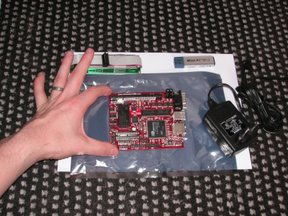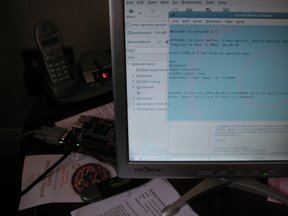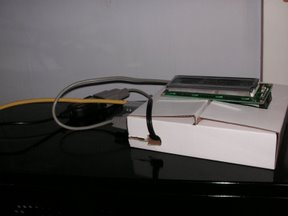The Weebox arrives!
…or at least the hardware does! After initial excitement in the morning when a package arrived — it was only the USB sound dongle — I spent the rest of yesterday listening out for the tell-tale diesel engine of a delivery van. At about 5.30pm, the very nice man from UPS turned up with my package from Embedded ARM. After a small altercation about import duty (involving a quick trip to the cash machine!) I was finally able to lay eyes on my purchase.
Initial impressions were good — everything that I ordered was there — yay! The power adapter was a continental one, rather than a UK one, a bit of a disappointment but I knew with a bit of biro-in-the-wall-socket action I could coax it to plug in.
My excitement was a bit short-lived when I looked at the power cable and realised that it just ended in a block terminal — the same as the one on the board — not an obvious plug me in job. A quick read through the instructions and it implied I needed to wire the power directly in. Great — no problem, the terminals came loose easily … but… which was positive and which negative? I made a guess, wired them in, and very briefly twitched the power on. The LEDs on the board all came on, convincing me that I had guessed the polarity correctly, so I turned the power on and left it on — all was well. Phew, first potential disaster over.
Now I had a powered-up tiny ARM computer running — yay! Let’s take a look at it. I dug out a null modem serial cable from my bag of wires, and plugged one end into the box, and then hunted around the back of my PC to plug in the other end. Disaster! My main PC doesn’t have any serial ports! I suppose in this day and age everything’s USB or Firewire, of which the PC has a plethora of ports. What a pain! Luckily, my downstairs lounge PC has a serial port, so, almost falling down the stairs in excitement, I set up all the gear on the lounge table.
Within a few minutes (getting bloody terminal emulators working is a right pallaver) I was presented with a boot screen!
Yay! From then on in it was a case of just playing with the flash memory, NFS mounts and so on. I briefly tried out the LCD display too, that’s all working too. One thing I discovered at this stage was how to stop Redboot from auto- running linux: The instructions tell you to hit ctrl-C at the Redboot prompt, but that wasn’t working on some terminals. After faffing around I found a terminal program which let me do so, and subsequently I realised it wasn’t the terminal but the line settings. To interrupt Redboot’s script you need to ensure your serial connection has no flow control enabled at all.
I’m now spending all of today just getting the system set up nicely — I’ve just been into Maplins to buy a USB to serial adapter, and that’s working a treat. As a fringe benefit, the box the adapter came in (after a bit of Stanley-knife action) has doubled as the development enclosue:
More pics on the Weebox Photo Album. Next step — getting the USB wireless card and USB sound dongles working!


